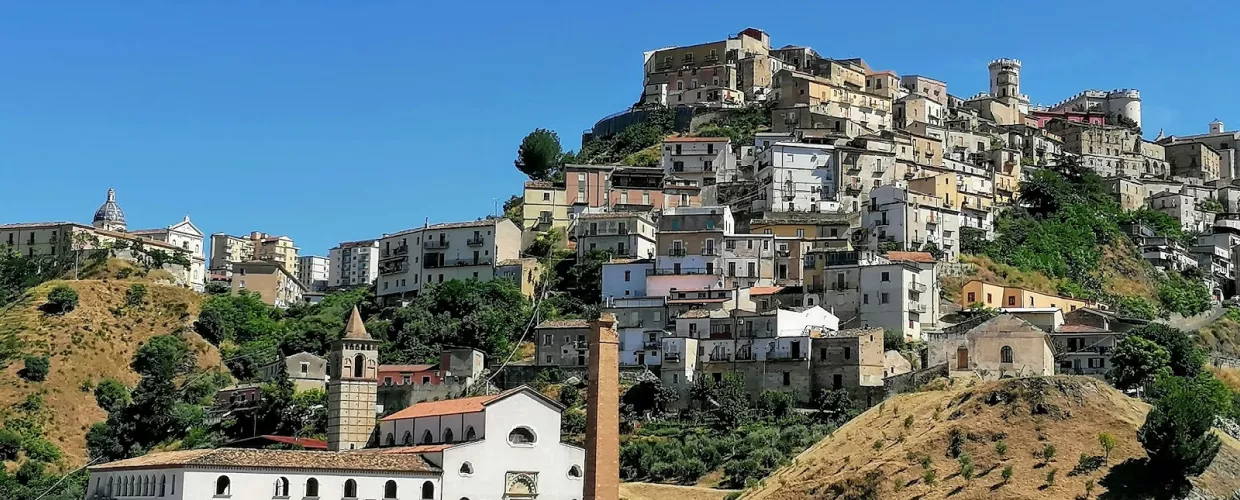This content was automatically translated. View the original text.

Overview
Corigliano is located on a small hill surrounded by olive groves and brightly coloured citrus orchards, protected to the south by the imposing La Sila massif and to the east by the turquoise waters of the Ionian Sea. The Mediterranean climate offers delightful temperatures all year round. Boasting a rich history, it was here that Charles III, King of Naples, who ruled towards the end of the 12th century, was born. The Ducal Castle, built in 1073, recently restored to its former glory, is a must-see for visitors. You’re sure to be fascinated as you stroll through the historic centre, with its narrow streets, ancient mansions and places of religious worship.
The Ducal Castle
The Ducal Castle of Corigliano has stood tall at the southern entrance to the plain of Sybaris for almost seven centuries now, built by the Normans, in their campaigns to conquer Calabria and Sicily, as a primitive stronghold to defend the town and control the plain below. Although renovation work (which began in 1490) almost completely erased all traces of the original fortified building, it is still visible in the stratified stones of the castle, the succession of inhabitants, the changes in style, and its slow transformation from a military fortress into a residence. It houses the Library of the Magna Grecia, the Museum of Image and a Hall of Mirrors, as well as a shop selling local products. Don’t miss the binoculars that point towards the Plain of Sybaris, which, thanks to technology, you can explore on a journey through space and time. There is also a telescope on top of the dungeon, which uses software to show the sky that day and back in 510 BC, when ancient Sybaris was destroyed.
Marina di Schiavonea
Near the urban area, you will find Marina di Corigliano (also called Schiavonea). In this wonderful location, you can let yourself be caressed by the clear waters of the sea under the summer sun as you enjoy entertainment provided by the welcoming residents, who keep local traditions alive. Schiavonea is embraced by the Pollino and Sila Mountains, immersed in the smell of orange blossoms, where the famous clementines are grown. It is a fantastic location all year round, thanks to its location and climate. In the summer, the scorching heat is tempered by the coolness of the surrounding mountains and the sea waters, while in the winter you can enjoy local seafood and mountain products. With a beautiful seafront promenade, boasting various attractions for all ages, Schiavonea is the second largest port in Calabria, after Gioia Tauro.
We recommend visiting its beautiful historic centre, typical of seaside villages, with narrow streets that all lead towards the sea or the small squares by the marina. The church of Santa Maria ad Nives was built on the site of the old 17th-century church of San Leonardo. Today, this church stands next to a newly designed, much larger church, built in the 2000s, which is now not only dedicated to San Leonardo, but also houses the Black Madonna of Schiavonea. Schiavonea is the perfect starting point for exploring famous places from Greek-Roman history, including Byzantine and Norman sites. You can visit the archaeological park of Sybaris and adjoining museum, Corigliano Calabro with its imposing Ducal Castle, Rossano, a Byzantine city with a museum housing the Rossano Gospels, and the city of Amarelli liquorice.
Food and drink in Corigliano
Corigliano Calabro is among Italy’s renowned cities of flavours. Its climate allows for the large-scale cultivation of oranges and clementines, as well as the production of olive oil and wine. Corigliano’s cuisine is simple but intense in flavour and highly inventive. The most common ingredients are vegetables and pulses, accompanied by pasta or other starchy foods. One of the main stars of the local cuisine is excellent-quality fish, which is caught in large quantities by local fishermen.
It hosts many festivals throughout the year, during which you can taste all kinds of typical dishes, starting with the Sagra del pesce azzurro (Blue Fish Feast), held in Schiavonea in early August, with local specialities from fried fish to more elaborate dishes. A typical first course dish in Corigliano is tagliatelle with chickpeas, which you should savour after first trying one of the many typical cured meats, such as soppressata salami, salsiccia di montagna (mountain sausage) and capocollo pork cold cut . Another typical dish is “a pasta chjna” (baked lasagne), which you can eat alongside local cured meats and excellent home-made red wine.
In summer, you can enjoy the famous “mulincian chjine” (stuffed aubergines) and “a pitta chjna” and “ri gurpinella” (sweet, stuffed focaccia and dumplings filled with jam, sultanas and nuts).
On the evening before the feast day of Santa Lucia, on 13th December, it is customary to eat “trìrice cose”, that is, 13 types of fruit, which must include, according to tradition, “a murtìlle, i melle e ri pizzingàngule” (blueberry, medlar and arbutus berry). The history of this location is guided heavily by traditions handed down through the generations.
Corigliano Calabro CS, Italia